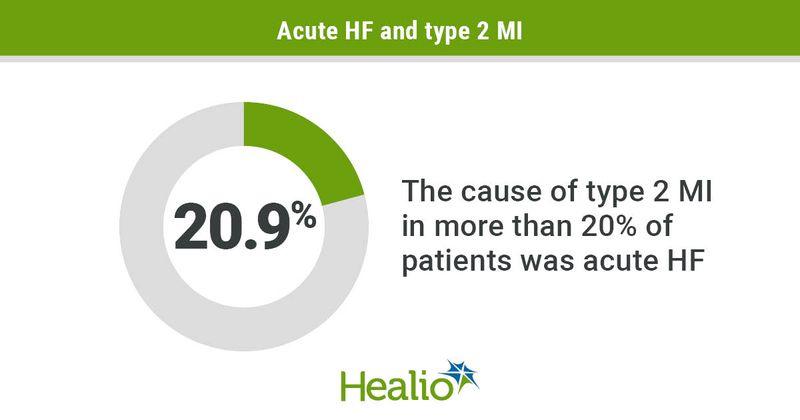New, worsening HF most common causes of type 2 MI
New and worsening chronic HF were the most common causes of type 2 MI, and 20% of patients with a type 2 MI event were readmitted for HF within 1 year, according to data published in the Journal of the American Heart Association.
“The relationship between type 2 MI and heart failure is underexplored. The two conditions are closely intertwined: HF can be both a precipitant of type 2 MI but also be an adverse outcome of the infarction,” Cian P. McCarthy, MB, BCh, BAO, cardiology fellow at Massachusetts General Hospital, Boston, and colleagues wrote. “Given the morbidity and mortality associated with HF, identification of at-risk patients is critical to facilitate primary and secondary preventive interventions.”

Researchers identified 359 patients with type 2 MI (mean age, 75 years; 57% men) from a large tertiary hospital from October 2017 to May 2018 to be included in the longitudinal study. Physician chart review determined patient characteristics, type 2 MI causes and subsequent hospitalizations for HF.
In the cohort, 184 patients presented with a history of HF (mean age, 78 years; 60% men) and 10.6% died in the hospital. There were 180 patients with ejection fraction assessment, most of whom had preserved ejection fraction (59.4%), followed by reduced ejection fraction (30%) and midrange ejection fraction (10.6%).
Researchers observed acute HF as the most common cause of type 2 MI (20.9%). Among the 75 patients with type 2 MI precipitated by HF, mean ejection fraction was 53%, and 21.3% had a de novo diagnoses of HF. Of the 289 patients with type 2 MI discharged from the hospital with available follow-up data, 5.5% were hospitalized with acute HF within 30 days, 17.3% were hospitalized within 180 days and 22.1% were hospitalized within 1 year.
When conducting the subgroup analyses, researchers observed a 34.2% HF hospitalization rate at 1 year among 161 patients with type 2 MI and prevalent or new HF. This rate was higher compared with the 7% rate among 128 patients with type 2 MI and no HF diagnosis at hospital discharge.
According to the researchers, this study demonstrated that patients with type 2 MI are at high risk for new or recurrent HF hospital admissions after their type 2 MI diagnosis.
“In patients diagnosed with type 2 MI, initiation of or optimization of guideline-directed medical therapy should be strongly considered among patients with a history of or new diagnosis of HF in order to modify their risk of subsequent events,” the researchers wrote.
